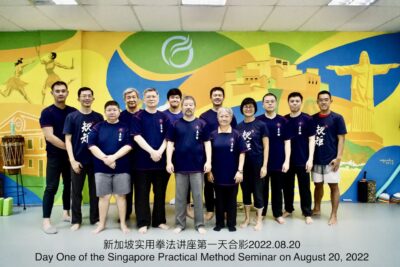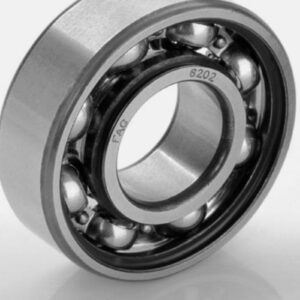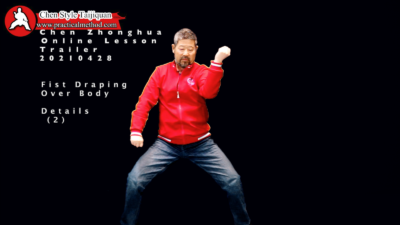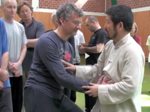- One must truly not move.
- This means one must have a centre, a centre line or a dot. This can be the centre line as a vertical stick which can rotate from the top as the non moving point.
- As the centre is established, then the two ends must be moved.
- When the two ends are moved, one`s producing a lever.
Knowledge : Thoughts and Understanding
DaQingShan is a place I have fond memories of. Previously, I had visited in May 2016 and Apr 2018, and each time I returned home with a bountiful harvest. Firstly, the training intensity is on another level compared to our local training in Singapore. We train four times a day starting from 6am in the morning and ending at 9.30pm in the evening, with meals and rest in between. Secondly, the environment is extremely conducive for training; the weather is cool and dry, and the air is fresh and fragrant from all the natural flowers and vegetation. Thirdly, there are many like-minded students with various different backgrounds passionate about learning and sharing the Practical Method system. Lastly, food and lodging are provided at a very affordable rate. To me, these are the ideal conditions for training and improving one’s skill.

Ever since COVID-19, it became near impossible for International students to travel to DaQingShan. But finally in 2024, DaQingShan is once again reopened for the International students. I took the opportunity to travel here from 3rd to 12th May 2024, along with two other Singaporean students who also wanted to experience the life here. During this period, a workshop was held from 1st to 7th May, followed by the 2024 China Wulian 8th Fucai Cup Daqingshan Taijiquan Invitational Competition from 9th to 11th May. The competition comprises of various events: moving step push hands, fixed step push hands on wooden piles, group and individual performance. Of course, I registered for every single one of them other than the group performance event.

The mood on the day before the competition was incredibly tense and exhilarating. Starting from the afternoon, competitors around China began streaming in one by one, greeting one another like old friends. When it came to the time of measuring our body weights, these competitors stripped down to their underwear, and that’s when I really noticed how lean and muscular they were. I could tell each of them had put in a lot of time and effort into their training, and they even kept their weight as high as possible within the weight category they are fighting in.
My objective for joining the push hands competition was simple: to pressure test myself against other competitors to see how I would fare, so I could identify the areas to improve on. The competition uses a double elimination bracket system, which meant participants need to lose twice before they are eliminated. This was great news to me, as I believed I would be able to acquire more experience from this competition regardless of winning or losing. Unfortunately, during my first match, I accidentally pulled my left shoulder and right thigh muscles, and was unable to compete in the subsequent push hands matches… Nevertheless, I’ve gained plenty through that one round.
Set Your Own Tempo
During my match, my opponent came in strong and fast, and my body reacted to it subconsciously. I tried several times to regain back my control, but kept reverting back soon after due to the intensity of my opponent. And as expected, once I played into his game, I was not able to beat him in terms of his physical abilities. Setting my own tempo is something that I haven’t quite comprehend yet, but I believe I’ll have to accumulate even more push hands experience to truly appreciate.
During the match, I was still unable to execute my moves properly. When I watched the video recordings of my match, I noticed that my body was disconnected and I was trying to rotate with the top half of my body. Furthermore, the stability in my lower body was still lacking. After seeking some advice from my senior brothers and sisters, I realised I was not focusing on the right areas when doing some of the basic foundations, which telltale signs are shown during the match. This is something that I’m currently working on every day since returning back to Singapore.

The Opponent is a Tree
Outside of the competition, one of the biggest takeaway I got from shifu Chen Zhonghua during the workshop is to imagine myself as a monkey and my opponent as a tree. A monkey does not try to push or pull the tree, but rather swing around its branches and manoeuvre around it. It does not seek to break, but to utilise the branches to its advantage. This mindset is fascinating to me, and I’m looking forward to incorporate it into my future push hands training as well.

Overall, the three of us from Singapore really enjoyed the trip, and would have loved to stay longer had it not been for work commitments. We trained a lot, ate a lot, and made many new friends along the way. We look forward to the next time we meet again!




Trust in the Process
Strangely, everything changed once I stopped resisting. The opponent who was aggressively attacking suddenly started to back away from me. And in turn, that made me feel more confident to get close. I could feel the moves the opponent made were not as effective and he was getting more and more tired as the match continues. And finally I was able to take advantage of a moment when he was trying to execute a move to execute mine and scored a point. Shifu has demonstrated this many times, that he is able to get in close to his opponent effortlessly. He has always reminded not to power up, but somehow it has always felt very counterintuitive for me before. I had tried not to power up but there was always some hesitation within me in the past. It is at this stage of training where I fully trust in the system that I appreciate his words. What appeared to look weak turned out to be really strong!
Just Keep Practicing
I realized the only way to truly trust in the process and remove all doubt and hesitation is through consistent practice. Even if you do not feel it now, all the practice will slowly accumulate over time and bear fruit eventually. In the past, I was not able to feel the effectiveness of the system and thus was not confident enough to rely on it, so I always end up falling back to my physical strength. But through all the practice, I began to become more aware of the various connections within my body and am now able to execute moves that my body was not capable of in the past. This year, I’m finally able to feel my lower body’s connection to the ground, which in turn strengthen my mindset that no matter how hard the opponent pushes, I’m confident that I will not fall so easily. So at the end of the day, it was the practice that brought about the change in mindset. So practice, practice, practice!


Presenter: Pawel Mueller Length: 2 mins Difficulty: 3/5 Language: English
Year: 2022 Location: Vienna, Austria
If you like this video, there is an even greater value in purchasing one of the packages below.
Purchase 2022 Full Year Online Class Video Package
NOTE:
- Video packages are designed for the convenience of students.
- Some packages are in fact classifications of videos.
- Some videos in packages might have been published and purchased by you individually.
- Average prices of videos in packages are considerably lower than individual videos. The number of videos in the package will increase until the sum of all individual video prices equal to two times or more of the package price.
- In view of this, if you have purchased a video that are also included in a package your have purchased, or vice versa, we will not give refunds or equivalents.
- All videos in packages are paid videos. They are restricted to your personal viewing and other usage. You do not have copyright of the videos and therefore you do not have permission to give/share with others.
- Please note that as a customer/user of the website and/or student of Chen Zhonghua, you have given him and the companies/organizations he represents permission to use videos or photos with you, both personally and commercially.
- Making a paid purchase constitutes agreement to the above terms.
Three parts in ball bearing: outer ring, inner ring and the balls in between we consider as one part.

Taiji is three.
Three steps: 1. Different parts of the body are strong, hard and stiff, which able to combine and recombine into pieces which have the same quality, like the rings and the balls. 2. Establish relationship or connection between different pieces through joints, like the balls seamlessly in between the two rings (through separator and tracks on the rings), engine oil is the joints. 3. Press the button to run the machine.
Read more
Lean with Back (背折靠)
Right fist and rear kua line up.
Elbow as a handle goes around that line.
Shoulder goes down to the kua.
Kua comes up to the shoulder.
The two lines must be maintained, and they must interact with each other.
The freer the rest of the body with those two lines maintained, the more power there is.
Implosion
- Line up the dot underneath the front buttock and front heel, and pull them together.
The dantian needs to adjust to allow the rear foot to be pulled up.
Lock the head.
New Exercise
- This is an exercise that Master Chen Zhonghua learned from Grandmaster Hong. They did it at the park on the gravel. After this, they would do foundations every morning.
- Lie on the stomach, use the hands to pull up.
- Lie on the stomach, use the elbows to pull up.
- Lie on the stomach, use the shoulders to pull up.
- Only use one part to pull up, the rest of the body is just like sandbag being dragged.
- Need 3 ways to do the same looking move to be versatile, so the opponent can’t figure it out.
Wind up the clock. Lock one end to create spiral. 1.use body strength 2.body has the shape/structure of half pipe or spiral.
Read more

- Kua needs to turn over (tippie toe if needed to get maximum range of the kua turning over)
- Right hand-elbow-shoulder triangle must remain unchanged. This triangle plane must catch the opponent, like how an oar catches water one way but not the other.
- The right elbow going up is not just lifting the elbow. It is stretching the torso so much that it flips up the elbow. Shoulder must stay downwards.
- The right kua turns over as the right hand-elbow-shoulder triangle changes position.
- Left kua must open, and don’t let the left knee point to the ground. This is very difficult to do, so the instructor is likely not able to show this one.
- Central axis does not move.
- At the very last part of the movement, there is a stretch between the right elbow and the left elbow to catch the opponent, and then we rotate on the central axis, and this rotation being inside must be bigger than the outside movement to have power. This is an example of fajin when done quickly.
Back to the kua-to-hand exercise.
- Lock the hand, shoulder and kua as a triangle, which is a fixed plane.
- We fixed a dot on the plane, and we rotate on the dot without changing the plane itself.
- We put this dot just under the elbow.
- Kua becomes (就是) the hand. When the opponent touches our hand, it is the same as touching our kua. Ultimately, the opponent is touching the floor.
- Elbow does not move.
- Rotate the shoulder to cause the fist to change the direction.
Turning Flower over from the Sea Bottom
Today, there is a big breakthrough.
The shoulders finally find the kuas in this movement. It was very possibly due to the exercise taught on Mar 30, 2021:
- Use the kua to push the hand out. Shoulder, kua and elbow are one piece. The hand stretches against the shoulder. This is a very practical push hand move.
REMEMBER THE PROCEDURE that gets me here, but DON’T FOLLOW THE FEELING.
Fist of Hitting and Lifting
The flip from one side to another needs to happen because of torso going down. More precisely, the two shoulder-to-kua axes go up and down against the central non-moving axis. Read more
Fist of Lifting and Blocking 搬拦肘
- Lock the two elbows as if they are on a table
- The two fists only go up to go around. They also have to stretch against the two elbows. Imagine that you have a wall parallel to the chest right in front.
- The kuas control the rotation on the central vertical axis.
- The knees control the height of the body/torso.
- The elbow control the horizontal movement.
Common mistake in push hands:
- Shoulder tends to come up and have power (wrong).
- Kua tends to go down and not have power (wrong). Read more
Go over the threshold 过关: hand and shoulder
Get to the special spot 窍: tip of the elbow, inner spot of kua to come out, back of the knee to find alignment, spot at the bottom of the neck
Master Chen explained the switching of the kuas again, how they are like two credit cards touching each other in a T configuration. We need to create a gap and then do the switch.
Read more
Exercise 1: Use the kua to push the hand out. Shoulder, kua and elbow are one piece. The hand stretches against the shoulder. This is a very practical push hand move.
Exercise 2: Elbow Strike (the elbow has to come out)
Exercise 3: Double Push Hands: Pull the opponent in, Front foot goes forward, rear foot follows. Two hands go out from the dantian with a trajectory. We use the back foot to push.
Kelvin corrected me on Rub Right Foot & Rub Left Foot. Here are my notes on his instructions and comments.
Rub R Foot
1)Starting posture is High Pat on Horse – chest facing NW, right arm slightly bent at chest level, above R knee, L arm extended to the side, weight on R foot.
2)Pull L foot closer to R foot and rotate on L heel so that L foot faces SE. Shift weight to L foot.
3)Adjust R foot slightly by dragging its tip forward so that the the tip of R foot is behind the heel of L foot.
4)R shoulder facing SW, L arm wraps around R arm, open both arms to shoulder height, L arm backward and R arm forward, both palms facing down.
5)Kick R foot in SW direction, foot slightly arched. Do not use force to kick. You must stay balanced after making the kick.
Read more
We started with forearm lever exercise. Aim at a dot to create a pivot. The distance the elbows goes down is the same as the distance the finger tip goes up (assuming the pivot is right in the middle).
Ratio 1:1
The meaning is that nothing is left in the middle. Every in-coming thing must go out. This is also called neutralization.
When we eat rice, ideally, we just want the energy, and other physical things should come out of the body. However, there is always some small amount of material, e.g. mineral that remains in the body. This is what causes us to be sick and become old.
Resolving door: One side comes in, the other side goes out. The key is that the door is very solid.
In our movement, redirect the incoming force to the rear foot without moving.
To be soft, it must be solid plus rotation.
Train with the rear foot at the corner, and a big enough stance to lock the body (especially upper body).
Taiji is only realized with speed.
Read more
Started with basic foundation teachings with Kelvin.
Concept 1-Twisting Towel
The hand leads elbow away from your body. The elbow leads the hand in towards your body. The movement is originated from the Kua and not the hand or elbow initiating the movement. The concept of opening the elbow is to keep the hand and forearm on a straight line moving in and out of the tunnel or tube. Opening the elbow allows the movement to come more from the center of my body. Elbow and hand should not move too much into overextension. The movement should be limited to only what your Kua can open.
Concept 2- Lifting water
Half horse stance-distance ideally should be 3 calf lengths, shifting forward 1/3 in front distance and 2/3 rear distance. The Kua initiates the motion. The front shoulder, rear shoulder and hand begin in a triangle formation initially and then becomes a 3 points on a line. Kua should be opening the elbow. Hand are in a shape of tile with slight curve. Space between fingers and thumb closed and all fingers are extending. Wrist is sitting by extension of wrist and opening separating into opposite direction.
Exercise 1: Use the left hand to grab the right wrist, stretch the right fingers. This is not just a demonstration, it is the method to train. People often ask Master Chen how to train, in fact, he just showed us. We only need to do it 60 times in each session. Doing it 60 times means to not use too much power, or using the right amount such that you can do it 60 times. When you use the left hand to grab the right, squeeze the armpit to lock the left hand, so that the left hand itself does not move. In order to stretch, we must lock something.
Read more
When the body action is correct, the energy is wrong.
When the energy is correct, the body action is wrong.
Read more
Maintain two lines (This exercise came from Twisting the towel.)
- Head to foot
- Front finger tip to the central vertical line on the back
We want to first stretch things out, and then add something in the middle to further stretch a little bit. We must constantly add that little bit of stretch in our training. This is neigong training.
Read more
Fetch Water
Application: Shoulder strike (kao), power comes from dantian
Read more
What is success? It’s to never give up.
Why would one give up? He had a change of heart.
中文两字词语是阴阳的。信念 – 信往外,念往内。
Read more
Think about the rods/bars that link the old kind of train’s wheels together. Those rods only ever go forward even those each wheel only rotates. This is yin-yang reversal. There is a joint in the middle of the wheel, there is another joint at the place where the rod is attached to the wheel. If there is no such joint and the rod is totally glued to the wheel, as the wheel rotates, the rod will also turn around with the wheel.
Read more
Put the elbow on the table.
Shoulders goes down to the elbow.
Read more
During the class I was training the following exercise. I stopped now and then to write down what Master Chen was saying.
Read more
Importance of practicing yilu diligently – only then will you understand what Master Chen is saying – and your yilu will improve.
One principle 分陰陽 (Splitting Yin Yang). Example: Left vs Right. You need a vertical central axis to distinguish L from R. (You need 3.) Same with top and bottom.
六字真言: 不動 旋轉 開胯 (Don’t Move; Rotate; Open Kua)
Read more
Hold a rod not by grabing it with the whole palm, but split the span into two dots. One dot on the index finger underneath the rod acts as the pivot, and another one at the root of the palm placed above the rod acts as the balancing arm. We can tilt the rod the other end of the rod this way without lifting the rod itself.
This is what allows the power to go along the rod to the other end, and it is said to go over.
Read more
– Today we worked on Pole Shaking (Positive and Negative Circle).
During training (when we are not yet successful), we use extra effort and focus to get it. It is tiring.
Once you are successful, the body gets used to it and will not be tiring anymore. The hair has been combed. The effort has gone through a filter. Read more
This lesson is about staying on topic, and then categorization within a topic.
There are only 3 types of movements in Practical Method:
- Elbow-in (Pull)
- Hand-out (Push)
- Rotate Read more
The axis in real usage exists only functionally. 滚珠轴承 Ball Bearing.
We create a shell (restriction) on the outside, then the axis inside must exist, but you can’t touch it unlike a real rod in a globe.
Read more
Key things, e.g.
- Forward is to push.
- Backward is to pull.
- Middle is to rotate.
- Separation of yin and yang
We must remember the key things even if we don’t understand it. Read more



